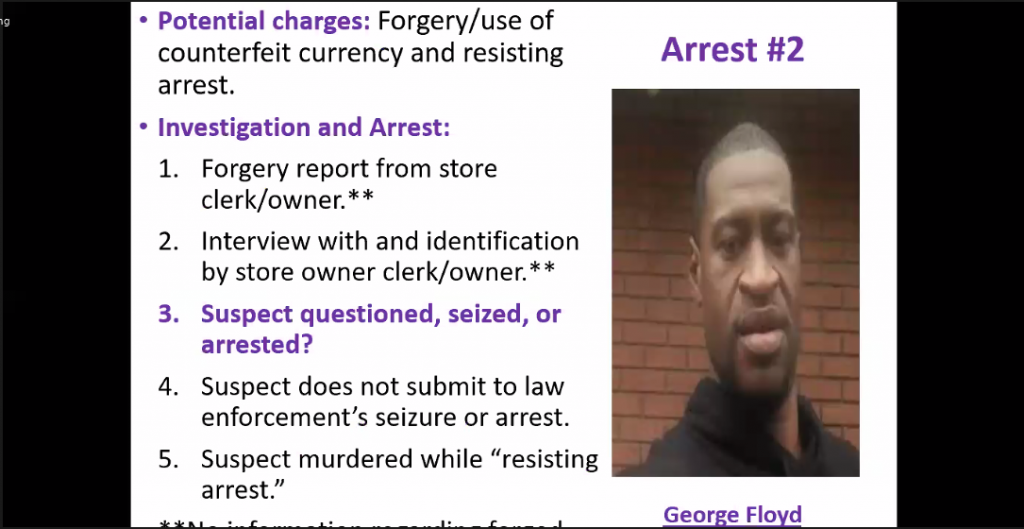The case of George Floyd’s arrest and murder is strange compared with other arrest cases and the process of arrest laid out by the law, a University of Idaho law professor shared today.
Shaakirrah Sanders presented the second webinar in UI’s Black Lives Matter Speaker Series today, called “A Legal Analysis of George Floyd’s Arrest and Murder.”
According to the series website, Sanders is the first African American and second person of color to achieve full professorship in the UI College of Law. She achieved full professorship in 2018.
Sanders explained the process of arrest and presented two cases to the audience: those of George Floyd and Anthony Brennan III.
“My hope is that these tales of two arrests will begin to lift the veil from those of us who are not exactly sure how it is or whether it is that our law enforcement agencies could use more training on diversity, inclusion and also more training about how to combat implicit and explicit bias,” Sanders said.
The fourth amendment of the U.S. constitution protects Americans against unreasonable searches and seizures while providing requirements for warrants, Sanders said. The amendment protects citizens’ persons, homes and the areas surrounding the home, papers and effects. Warrants, she said, must have a judicial officer’s signature, probable cause and a description of the person, place or thing to be searched or seized.
Sanders focused on the fourth amendment as it pertains to arrest. She said arrests can be made if a warrant is in place, if an individual commits a crime in the officers’ presence or if the officer has probable cause to believe a crime was committed. Arrests can be made for minor offenses, including jaywalking, an example she discussed in the webinar.
If a valid arrest is made, the search incident to arrest exception is triggered, she said. This means law enforcement officers can do more than pat down or frisk an individual at the time of arrest — instead, they may reach into pockets, unlimited in which evidence they decide to seize. If an officer decides to frisk an individual without a valid arrest being made, however, the officer may only pat the person down.




Four slides from Shaakirrah Sanders’ presentation | Courtesy
Sanders introduced Anthony Brennan III’s case after explaining how arrest is supposed to work under the law. Brennan, a white man, was arrested and charged with three counts of misdemeanor assault after he was videoed assaulting three people posting flyers in support of Black Lives Matter. Other individuals were falsely identified on social media by internet sleuths as the perpetrator of the crime.
Sanders said law enforcement reviewed video of the behavior, asked for tips from social media, obtained Brennan’s photo from his driver’s license, used facial recognition software and surveillance of the Brennan’s home, interviewed Brennan, consensually searched Brennan’s home and seized evidence before Brennan surrendered himself to the police.
“Law enforcement gets all of my thumbs and fingers up on this investigation,” Sanders said. “This is what I want to see from law enforcement. This investigation gives me all the faith that I need in our law enforcement agencies.”
This investigation, however, differed from George Floyd’s case.
George Floyd, a Black man, was murdered in police custody after a white officer, Derek Chauvin, placed his knee on Floyd’s neck for eight minutes and 46 seconds. Sanders said Floyd had allegedly used a counterfeit $20 bill to pay for something and proceeded to resist arrest.
According to Al Jazeera, Minneapolis Police Department statement said “after (the subject) got out (of his car), he physically resisted officers. Officers were able to get the suspect into handcuffs and note he appeared to be suffering medical distress.” The statement said the officers were responding to “a forgery in progress.”
As of June 12, the Minneapolis Police Department website is not online to verify these statements. A Forbes contributor alleged this could be due to hacking by the online collective Anonymous.
In Floyd’s case, Sanders said law enforcement received report of a forgery from a store clerk or owner and proceeded to interview the reporting party, but no further information is available on this claim. No body camera footage is available of the moments following this report and the questioning, seizure or arrest and subsequent murder of Floyd.
Sanders said the facts leading to Floyd’s death — and the presence of probable cause — are unclear to her.
“A mere report by an individual that a crime occurred is not probable cause, as we saw in the Anthony Brennan case. You need to get corroboration. And what’s interesting to me is we still have not heard whether that $20 bill was real or fake,” Sanders said. “And it seems to me that without that determination, no one should have put their hands on Mr. Floyd.”
UI Office of Multicultural Affairs Program Coordinator Vivi Gonzalez said the full event will be available to watch online later.
Lex Miller can be reached at [email protected]

